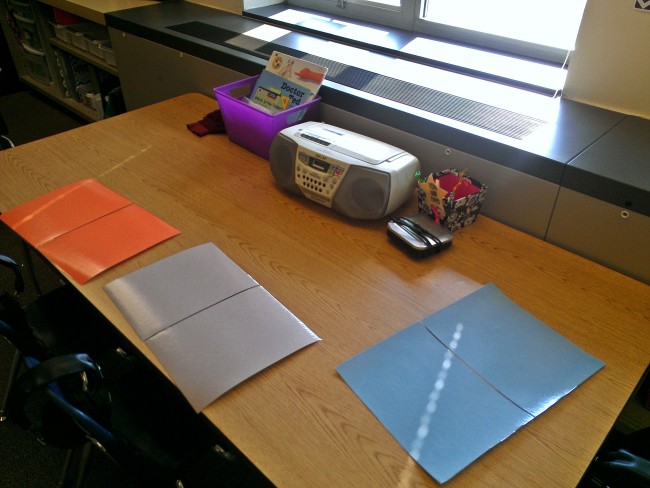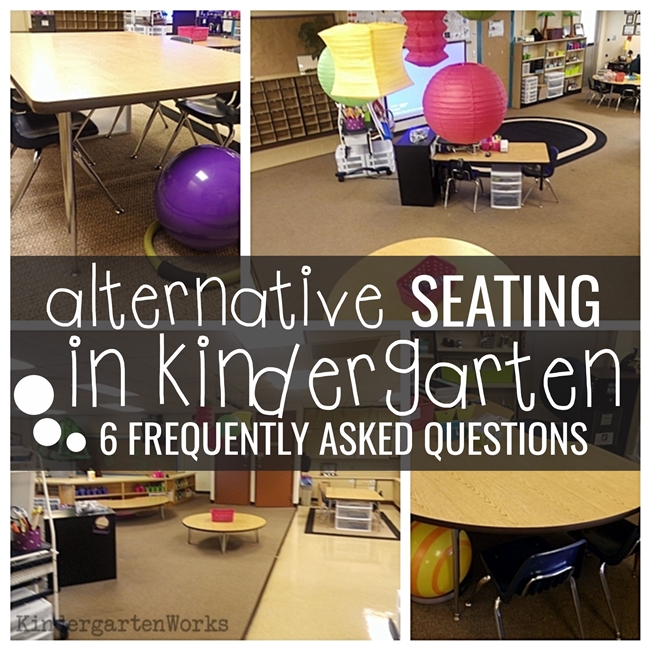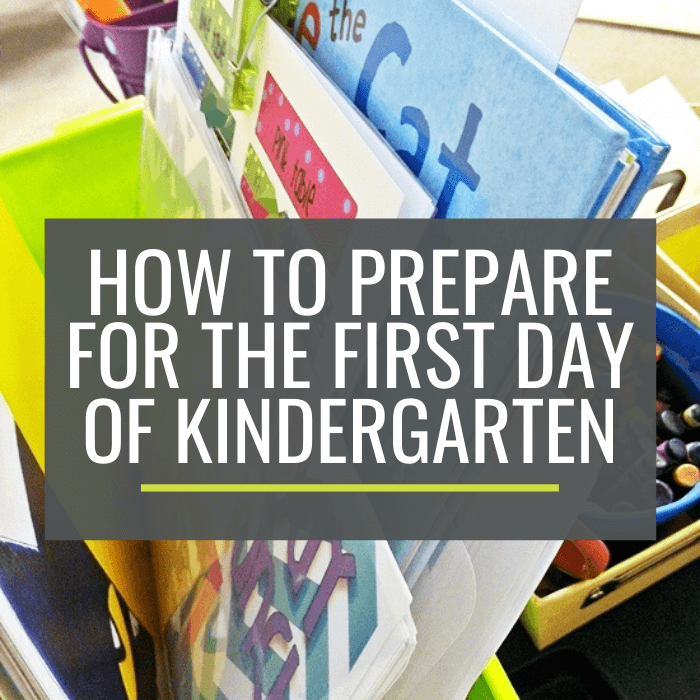How to Roll Out Student Work Spaces When You Do Alternative Seating
Someone asked me how I roll out alternative seating at the beginning of the school year.
Great question! Let me share my top tips on introducing and implementing alternative seating starting the first day of school.

Let me also remind you that when I first started because I got rid of my teacher desk, that I practiced on my kinders at the end of a school year, with 3 weeks left to go.
The following year, I knew that I wanted to keep my alternative seating setup.
I had fallen in love with how it worked, how much freedom it gave my kinders {and me} while building their ability to start learning how they best learn. {Big stuff for five year olds – don’tcha think?}
The tricky part came when roughly 2-3 days before school was going to start that I hadn’t really considered how I was going to roll out the use of these spaces with my new kiddos… let alone explain it to parents {who I anticipated could be wary} on our back to school night.
The plan
My plan was to keep it simple. Just the way I do most everything in my classroom…
I was going to teach, model, edify and release.
1. Teach
I did “assign” a spot to the names on my class list. I have no clue who they are based on their names {unless I’ve had a sibling} until our back to school night.
So, I don’t assign based on anything. It’s truly very random.
I did this using something very temporary – on purpose. I used very sticky sticky notes and placed them around the room.
I specifically chose a number of standing spaces, sitting spaces, ball chairs, kneeling spaces – but opted for no floor spaces at this time.
I also chose to leave sitting spaces open. This was to make it a point that not every child is assigned a traditional space to those parents whose child did receive one.

I placed their art folders/space mats on top of the post-it note. The post-it was so that the name would still be there on the first day of school after I picked up their mats.
If parents asked at our back to school night, I tried to explain in an elevator pitch that their child would get to explore all seating options since our classroom runs based on choice for each activity we do… after they’ve learned how to appropriately use their assigned space.
2. Model
When teaching any activity the first day of school {and week really} I specifically chose to model said activity or work throughout the day at each of the different kind of spaces.
I mentioned the type of space, when it’s a useful type of space (like, “sometimes when we’re working hard it’s easier for our bodies to stand instead of sit”) and explain that they may want to try that kind of space in a few days.

The first time I mention the floor spaces using clipboards – they are all about it!
3. Edify
Every time I can I mention how someone is using their space appropriately. Es-pec-ia-ll-y with the ball chairs.
Positive praise is all it takes to help other kinders see how to use the different kinds of spaces and is simultaneously encouragement for them to try a variety of spaces.

I also take time to ask students {while there is a random lull} what type of space they’d like to try when they get to choose. The whole time they are assigned spaces, I’m building up expectations and anticipation for when they get to choose.
I also reinforce that choosing their space is always a privilege. If they choose a space and can’t choose to get work done there, then it may not be the right kind of space {or person} to choose, and I’ll have to choose for them.
4. Release
You’ll notice reading the steps above that I mentioned that I assign spaces. {Yep, I do} It varies from year to year how long they stay assigned, but usually within the first full week of school I announce that they can start choosing spaces. I prep them the day before… and the day of…
Normally, on the day when we begin choosing it’s my transition to any independent activity… I ask them what type of space they’ll choose before they leave the group.
The following day, I can do this less often.
On the third day, I barely say anything at all other than helping them make wiser choices if necessary.

I try to really be open-minded here.
Kinders are very creative and often think of using a workspace {or creating a completely new work space} in a way I wouldn’t – nor would have thought of.
So, I try to hang back and let them attempt using it in the way they desire.
How to Help Them Make Wise Choices
If a workspace begins to impede on their work or ability to focus, that’s when I try to intervene with a tweak, solution or suggestion to change the type of space.
That simply reinforces that while choosing a space is indeed fun, it’s choosing the right type of space for what your body needs while getting to learning that is important.
My motto concerning this really has become, “Sit, kneel, stand… just learn!”
I try to remember that as we get our year started out right.
From there on out, it’s full speed ahead and students get to choose their spaces each time during every independent activity during the day.
Let’s wrap it up
If you were wondering how to give it a go with your students, I hope this really helps! You can try it at any point in the school year!
If you like what I do here on KindergartenWorks, then be sure to subscribe today. I look forward to sharing ideas with you weekly.
Get the scoop on other must-know things related to alternative seating in our classroom.








What do you use the post-it note under the workspace mat for? Is it is just to designate specific areas that will be used during open house?
Hi Jill,
The post-it was so that the name would still be there on the first day of school after I picked up their mats. I left them there for like three days and then moved them so students could try a different type of seating space. I placed their work mats on top to start the day.
– Leslie
Thank you for the clarification! I think your roll out will really help me this year. I switched to semi flexible seating the 2nd semester last year and can’t wait to start from the beginning this year. I love the idea of workspace instead of seats.
My students use the floor (circle carpet mats) to do many different things, it is up to them. I still have two tables in my room, but carpets, carpet mats, and pillows too. They love to be able to change around as they want to. I do not have a teacher desk and have never missed it. I love your ideas. Thank you for sharing.
Awesome – love how all of your ideas are still conducive to getting work done. That’s key, isn’t it? Thanks for sharing!
– Leslie
Hey Leslie! I plan on starting this for the upcoming school year with my kiddos! I am so excited and this really helped to explain it. I wanted to know what those pink things were at the bottoms of your chairs. It looks like something the kids could put their feet up on? Thanks so much!
Hi Teresa, I’m excited for you! Those are exercise bands from the dollar store – kind of “kicking bands” so that they could tuck their feet under or behind and have something to feel resistance against. Although they could put their feet on top too. I had to add some serious gorilla tape to make it fit our teeny chairs, but it worked decently. I only put in 1-2 in our room.
– Leslie
I got approval from my principal to adapt my classroom similar to your. I would like to see what you leave for a sub.. Thanks from a first grade teacher! 🙂
Hi Dustin – congrats that’s awesome! I don’t have anything in particular that I leave for a sub that is just about the seating arrangement.. but then I never have. I just write out a few general statements about my classroom expectations and the alternative seating is just a part of that. I do explain if someone has an assigned seating space (let’s say for a behavior reason) and I always leave a set of name label stickers so that they can call on someone without needing a desk name tag. I hope that helps in a small way at least!
– Leslie
I have one more question for you: Do you do any sort of data collection regarding the effectiveness of your classroom environment? I am working with a coach from my AEA on this and we would like to collect some data. Any thoughts?
Hi Dustin, no data collection was needed. I’d suggest, like with any data collection, to identify 1 or 2 very specific goals (at the most) that you can track in observable ways. If you want to see if it improves time on task, track that. You’d need to collect data before hand to have as comparison though… Diffident seating works for different kids! I was just mentioning to a teacher about 3 kinders who routinely choose to stand at every opportunity. They knew themselves best and they just so happened to all qualify for a gifted/talented program the following year. It may be small, but I’m glad they got to work in an environment with choice.
Leslie
I used this post as the jumping point for my 4th grade deskless classroom this year. It was the first post I found that really explained what I was imagining for my room. Then, I read more of your posts and knew this was what I had to do!
After explaining it to my principal, she jumped on board and helped me find some round tables and some taller tables. I also grabbed a coffee table with some body pillows. I don’t require them to sit at the tables, but they are certain welcome to sit there if they desire. Some students still gravitate to the tables, but many are preferring the saucer chairs, bean bags, balance balls, and pillows.
Thank you for this post!
It’s still a work in progress (needing to add more alternative seating), but here is my new room. I love it!
https://www.facebook.com/media/set/?set=a.10101739505414207.1073741849.20620824&type=1&l=1936a2e046
I’d love to hear how your year has been going! I hope it’s been a smooth transition (and your students know how lucky they are too gave you)!
Hi! This is a great explanation of how you roll this out. Thanks! I am doing alternative seating this year and I am super pumped! I was wondering if you could give more information of how you organize supplies for the kids? I love the student work space too!
Hi Ashley, thanks for sharing that you’ll be giving this a go!
Do you mean supplies like pencils, crayons and glue? In the picture above that has the words overlayed onto it (sit, kneel, stand, just learn) you can see 2 sterilite drawer units. One is off to the right side of the picture (tucked under the table) and the other is located on the shelving towards the back left of the photo. They look like they have binders in the big drawers.
These are what I used to hold student supplies. There were a few stashed around the classroom – I tucked 3 under the ends of a regular-height tables and 3 were in other locations around the room. (I had 26 or 27 students and needed quite a few!) A group of students was assigned to one stack of drawers. They stored their pencil box (with crayons, 2 pencils, 1 marker and 1 dry-erase marker) in the top skinny drawer and their calendar math binders and writing folders in the larger drawers. I also tried using book boxes one year, but this worked a little better for me since we kept knocking book boxes over and it kept more counter space clear.
Any other supplies needed like scissors or glue were stored in the areas where they would need them most. I would always keep additional supplies available too for students who lost theirs from their pencil boxes (and stored a class set of scissors here as well for whole group projects) https://www.kindergartenworks.com/classroom-management/responsibility-in-bucket-kind-of/.
– Leslie
First, thank you so much for replying! And yes that is exactly what I was wondering about! I have always used seat sacks and that will obviously not work. I had thought about the sterilite drawers as an idea so it really helps to know how you use them! Thanks!!
Anytime! Let me know what solution you come up with too and if you love it or not 😉 There were times that the drawers didn’t work amazing for me (the big ones got a little disorganized for my taste) but the pencil box drawer part always worked well!
Ashley, I am doing something like this as well. I have tupperware containers that house student crayons and colored pencils. Each box is for about 6 students. I have community glue, Expo markers, etc.
I have Sterilite drawers for their spiral notebooks, pocket folders, and pencil bags. Their 3-ring notebooks go on the shelf next to the Sterilite drawers.
I’ve done some rearranging since I took the pictures, but maybe my classroom photo album will still help:
https://www.facebook.com/media/set/?set=a.10101739505414207.1073741849.20620824&type=1&l=1936a2e046
Your photos look great Mary! I have considered doing something similar, but needed to break up the location of the items to around the classroom to break up congestion. Nice to know what can fit in that size of drawer unit!
– Leslie
Hi Leslie! What are some of your stipulations for the ball chairs?
Hi Jasmine,
Keep feet flat and no ridiculous bouncing 😉 Of course, we treat it the same as a chair so there is no rolling it or bouncing it with our hands either – that is immediate revoking of bouncy chair privileges for a loooong time. If they want to relocate it, they have to pick up the entire ensemble (holding it by the base) or sliding as they would any chair. I try I model how far their legs should be to properly support themselves and help tweak for those that need it.
– Leslie
Hi, Leslie–I’m taking several pages out of your book it seems! Even though I teach first grade, there is so much that you do in Kdg that can easily work in first grade. On assigning spaces, do you actually assign some standing spaces to kids as their workspace at the beginning of the year? I am just picturing trying to explain that to the parents or the kids that that’s their workspace and them thinking they’ll be standing all day. Or, do they all have a sitting space somewhere and as you move from one activity to another, they have the freedom of choice? If you could expound a little, I’d appreciate it. Another teacher and I are considering doing this, but alas, are a little hesitant to give up the old way! ha Thanks. Laurie
Yes I do assign standing spaces Laurie! Parents did ask questions, but I tried to explain that we barely are at our independent work spaces for more than 10-15 mins. at the beginning of the year and that it is a highly popular choice once released to the entire class. I usually mention that and say of course, if it is uncomfortable for their child or seems to be impeding their schooling then we can make immediate changes. I also am sure to let them know that their child will have the option to choose for every activity in just a few days. They end up having the freedom of choice for every activity once released, but there are so few times that they are doing anything “independent” at least for us in k anyway the first three days of school. I am sure to share my excitement in my voice and that helps!
– Leslie
Thanks for sharing! I was planning to implement from day one as well… I love the way you’ve built in a little time before they are totally making the choice on their own. Great advice! ~ Ana
Thanks Ana! Best wishes to you!
– Leslie
I have ball chairs in my classroom, but they have four little rubber legs on the bottom. This seems to be where the leaks occur due to wobbling, which should be expected. I like your style with the circular bottom. Could you share the brand and where you bought them, please? I know I will need to replace the ones I have this year and really did not want to go to the expense of the ones that seem to fit in the coaster bottom and had a back like a computer chair. Thanks.
Sure thing Betsy – they are from Walmart as seen here: https://www.kindergartenworks.com/teacher-organization/better-way-to-do-this/ (at the end) just be sure to buy the largest size (even though it’s a slight difference between the balls – almost not noticeable to the eye at first). Hope that helps! It’s just a yoga ring to hold the ball generally in place.
– Leslie
Thank you. I’m feeling silly now. Definitely time to get back into my classroom and use those CLOSE READING skills. I missed your explanation in the original post. This looks like a massive $$$-saver.